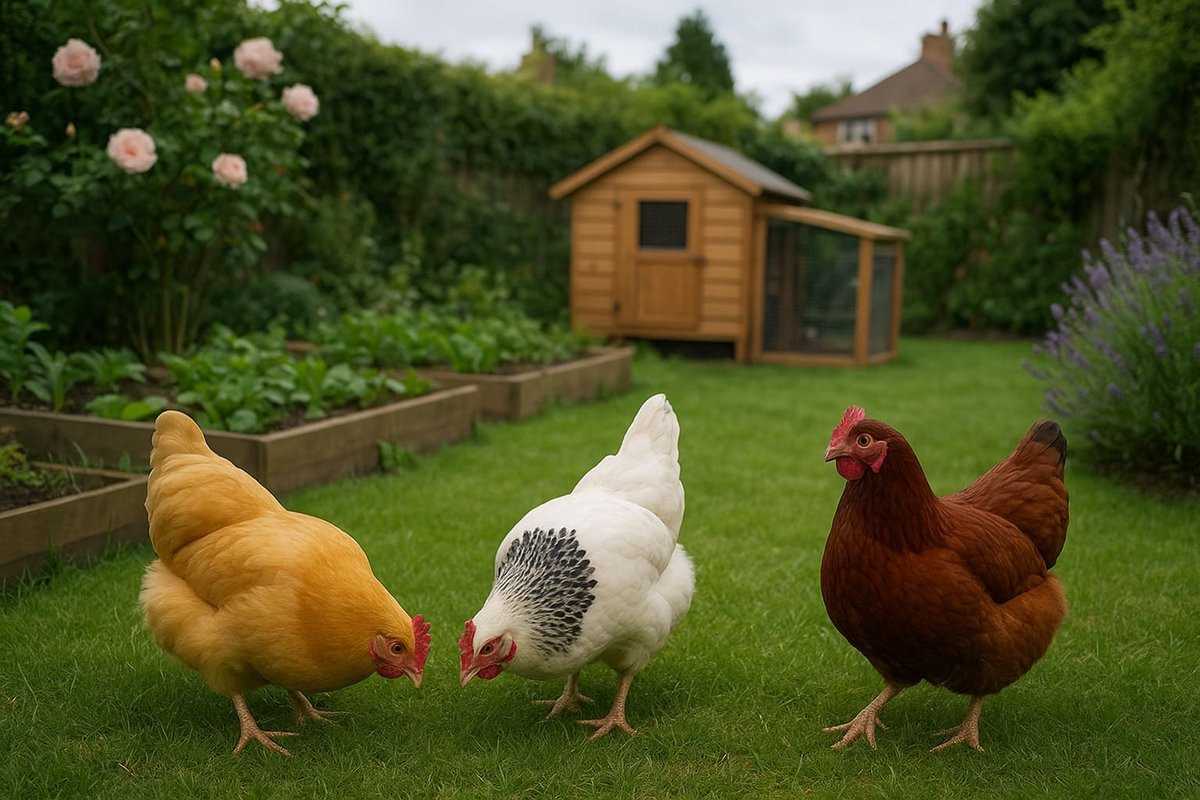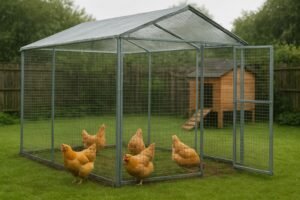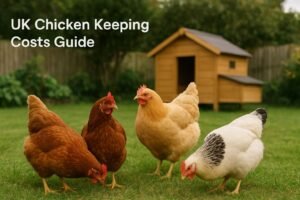Welcome to your complete guide to the “big three” traditional British chicken breeds. If you’re a UK backyard chicken keeper, or thinking about becoming one, you’re probably looking for birds that are hardy, friendly, and well-suited to our unique British weather. This is where our classic heritage breeds shine.
We’re going to dive deep into the Sussex, the Dorking, and the Orpington. These aren’t just any chickens; they are living pieces of British history, and they just so happen to make fantastic garden pets. Forget the flighty, fragile birds you might have heard about—these breeds are loved for their calm temperaments, reliable egg-laying, and suitability for everyone from total beginners to experienced keepers.
In this guide, you’ll learn everything you need to know about their different personalities, egg production, and specific care needs to help you decide which one is the perfect fit for your flock. For a brilliant overview, you can also check out this complete guide to keeping chickens in the UK.
Understanding Traditional British Chicken Breeds
What Makes a Breed “Traditional British”?
When we say “traditional” or “heritage,” we mean breeds that were developed right here in the UK, often generations ago. These are pure breeds, not modern hybrids. They were bred for a specific purpose, like laying eggs through a damp British winter or providing a high-quality roast for the table.
To be officially recognised, a breed must meet the standards set by the British Poultry Standards, which are maintained by the Poultry Club of Great Britain. Keeping these standardized breeds helps preserve genetic diversity and a real, living part of our history.
Why Choose a Heritage Breed Over a Modern Hybrid?
This is a really common question. Modern hybrids (like the brown hens you see in farms, often called ISA Browns or Warrens) are bred to lay an incredible number of eggs—often 300+ in their first year. (This is why charities like the British Hen Welfare Trust exist, to rehome these commercial hens after their first laying cycle). So, why not get them?
It’s all about trade-offs:
- Lifespan: Hybrids often “burn out” after 2-3 years of such intense laying and can suffer health problems. Traditional breeds lay fewer eggs per year but will do so reliably for 4-6 years, or even longer. They have a much better chicken lifespan and longevity.
- Temperament: Heritage breeds are almost always calmer, friendlier, and more docile. They are bred to be handled, not just kept in a cage.
- Broodiness: Hybrids have had the “broody” instinct (the desire to sit on eggs) bred out of them. Traditional breeds like Orpingtons make fantastic, natural mothers.
- Foraging: Heritage breeds are excellent foragers, meaning they love to roam your garden pecking for bugs and weeds, which supplements their diet and makes for happier chickens.
- Hardiness: British breeds were developed to thrive in our damp, cold winters, unlike many more delicate breeds.
The 3 Main Types of Chickens
When choosing a breed, it helps to know what they were originally for. All chickens fall into roughly three types:
- Laying Breeds: (e.g., Leghorn). These are slim, flighty birds that put all their energy into laying a huge number of eggs. They are not very friendly and don’t carry much meat.
- Meat Breeds: (e.g., Indian Game). These are very large, heavy-breasted birds bred for the table. They grow fast but lay very few eggs.
- Dual-Purpose Breeds: This is the sweet spot! These birds are the perfect all-rounders. They lay a respectable number of eggs and are large enough to be considered good table birds. The Sussex, Dorking, and Orpington are all shining examples of dual-purpose breeds.
For most backyard keepers, a dual-purpose breed is the ideal choice, giving you the best of both worlds. You can see more in our full guide to the easiest chicken breeds for beginners.
British Chicken Breeds Comparison
Here’s a quick look at how our “big three” stack up against each other.
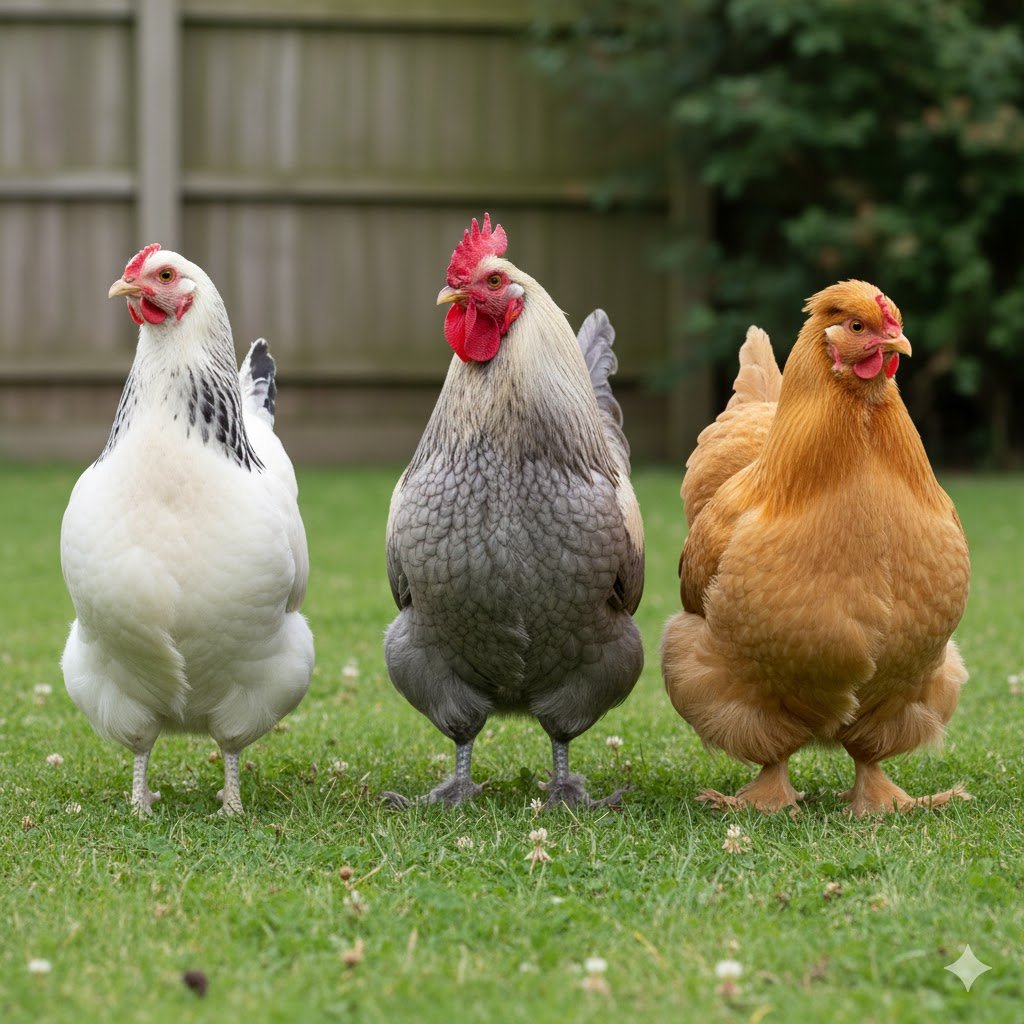
Quick Comparison Table
| Breed | Egg Production (per year) | Egg Colour | Temperament | Cold Hardy | Best For… |
|---|---|---|---|---|---|
| Sussex | 240 – 270 (High) | Cream / Light Brown | Friendly, Curious, Active | Yes | Beginners, Families, Eggs |
| Orpington | 160 – 220 (Medium) | Light Brown | Very Docile, Calm, Cuddly | Excellent | Families with children, Cuddly pets |
| Dorking | 150 – 190 (Moderate) | White / Tinted | Gentle, Calm, Quiet | Yes | Winter eggs, Meat, History lovers |
Best for Small Gardens & Bantam Varieties
A quick note on size. The breeds we’re discussing are all “Large Fowl,” which means they are big birds. If you’re short on space, the good news is that Sussex and Orpingtons (and many other British breeds) are also available in Bantam versions.
Bantams are like miniature versions, often about one-quarter of the size. They lay smaller eggs and fewer of them, but they need much less space, eat less feed, and do less damage to your lawn. They are a fantastic option if you’re worried about space. Check out this guide to the best chicken breeds for small UK gardens for more ideas.
Sussex Chickens – The Perfect All-Rounder
If you can only get one breed and you want a bit of everything, the Sussex is probably it. They are the classic, reliable choice for a UK backyard.
Sussex Breed Overview
- Origin: Sussex county, England, in the 19th century.
- Primary Use: Dual-purpose (a fantastic layer that’s also a good table bird).
- Popularity: Extremely popular with beginners and families.
- Main Varieties: Light, Speckled, Brown, Buff, Red.
Sussex Chicken Appearance & Varieties
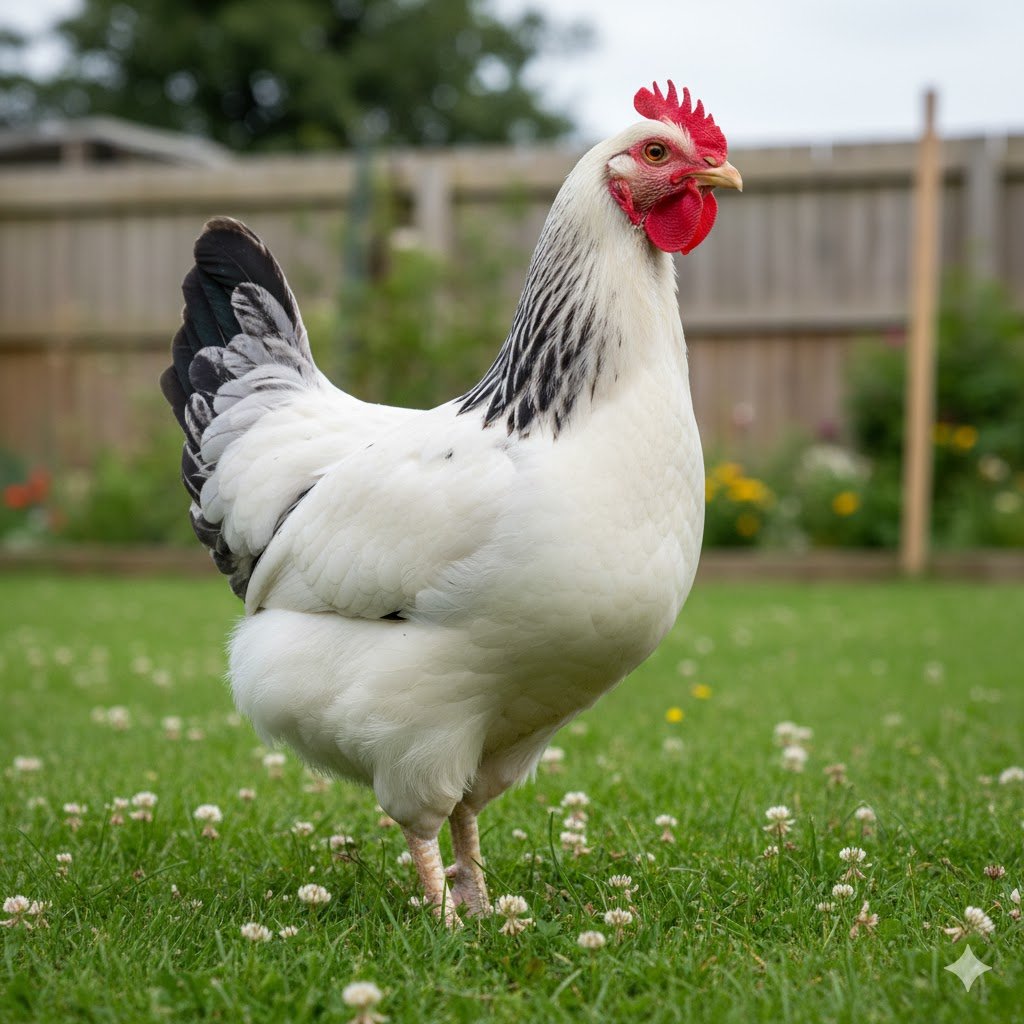
The Light Sussex is the most common variety you’ll see. It’s a beautiful, striking bird: a pure white body with a black-laced neck (hackle feathers) and a black tail. They look very smart and clean against a green lawn.
The Speckled Sussex is another stunner, with a deep mahogany-coloured body, where each feather is “speckled” with a white tip. They are fantastic at camouflage, which can be useful if you’re worried about predators. You can learn more about the stunning Speckled Sussex variety in our dedicated guide.
All Sussex are large but active-looking birds with a single comb and white legs.
Sussex Egg Production & Laying Ability
This is where the Sussex truly shines. A good hen will reliably lay 240-270 cream or light-brown eggs per year. That’s a very impressive 5-6 eggs a week in her prime.
Crucially, they are known for being good winter layers, meaning they are less likely to stop laying completely just because the days get short and dark, which is a huge bonus in the UK.
Sussex Temperament & Behavior
Sussex are wonderful. They are:
- Friendly & Curious: They will follow you around the garden to see what you’re doing.
- Active: They are brilliant foragers and love to have space to roam.
- Gentle: They are not typically aggressive and are great with children.
- Adaptable: They are happy either free-ranging or in a large, secure run.
They’re not as “cuddly” as an Orpington (they have things to do!), but they are a constant, friendly presence.
Sussex Pros and Cons
| Pros | Cons |
|---|---|
| ✅ Excellent egg layer (240-270/year) | ❌ Can sometimes go broody (but not as often as Orps) |
| ✅ Good winter layer | ❌ Light Sussex’s white feathers can show dirt easily |
| ✅ Very friendly and curious | ❌ Can be bullied by more aggressive breeds (rare) |
| ✅ Hardy and handles UK weather well | |
| ✅ Brilliant forager (cuts feed costs) | |
| ✅ Great all-rounder for beginners |
Dorking Chickens – The Ancient Briton
If you want a truly unique, historic breed with an incredibly calm nature, look no further than the Dorking.
Dorking Breed Overview
- Origin: Dorking, Surrey. This breed is ancient—it’s believed they were brought to Britain by the Romans.
- Primary Use: Originally prized as a table bird (the “Dorking Fowl” was a luxury), but now kept for its winter eggs and gentle nature.
- Status: A rare, heritage breed. You’ll be helping to conserve a piece of history.
- Main Varieties: Silver Grey (most common), Dark, Red, White.
Dorking Chicken Appearance & Unique Features
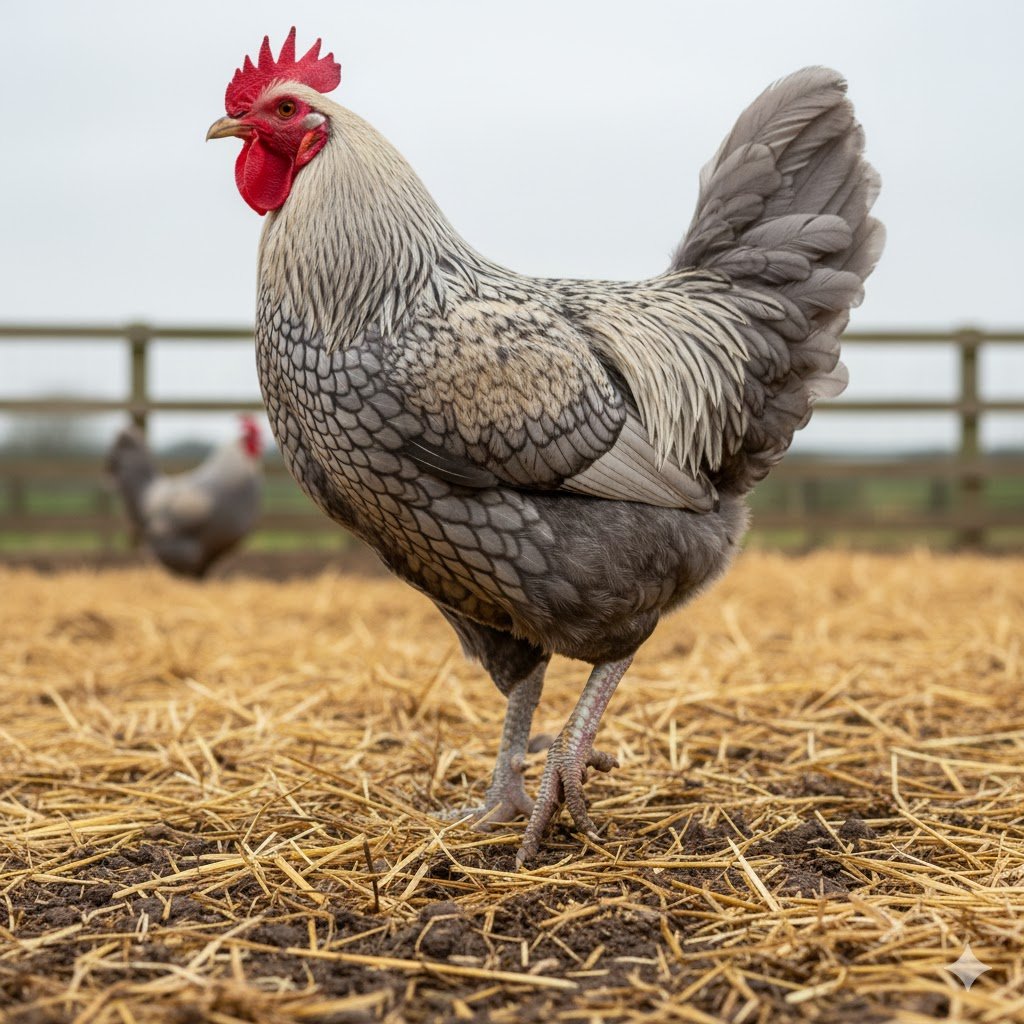
Dorkings look completely different from the other two. They are large, long, and rectangular-bodied birds that sit on surprisingly short legs.
But their most famous, tell-tale feature is their five toes. (Almost all other chickens have four).
The Silver Grey Dorking hen is beautiful, with a silvery-white head and neck and a salmon-coloured breast. They are chunky, solid-looking birds that potter around calmly.
Are Dorking Chickens Good Egg Layers?
Yes, but moderately. You can expect 150-190 white or tinted eggs per year.
Their secret weapon is winter laying. Dorkings are famous for producing eggs right through the darkest, coldest months when almost every other hen has stopped. Many keepers find that a Dorking will give them more eggs from October to February than a Sussex will.
Are Dorking Chickens Good for Beginners?
They are a fantastic, gentle breed for beginners, with one catch: they can be bullied. Because they are so calm and non-confrontational, they are often at the bottom of the pecking order. They are best kept in a flock of other gentle breeds (like Orpingtons or other Dorkings).
Dorking Temperament & Behavior
Dorkings are, without a doubt, one of the calmest and quietest breeds.
- Incredibly Gentle: They are placid, serene, and very easy to handle.
- Not Flighty: They are heavy birds with short legs and can’t fly well, so low fencing is fine.
- Excellent Mothers: Dorking hens are famously broody and make wonderful, protective mothers.
- Quiet: They are not a noisy, chatty breed.
Sourcing Your Dorkings: The Rare Breed Challenge
You won’t find pure-breed Dorkings at a standard farm shop. Because they are a rare breed, you’ll need to find a specialist breeder. The best places to look are:
- The Dorking Club UK (the official breed club).
- The Rare Poultry Society members’ list.
- Specialist poultry shows (like the National Poultry Show).
Dorking Pros and Cons
| Pros | Cons |
|---|---|
| ✅ Exceptionally calm and gentle | ❌ Rare breed – harder to find and more expensive |
| ✅ Fantastic winter egg layer | ❌ Lower egg total (150-190/year) |
| ✅ Very quiet, good for neighbours | ❌ Low in pecking order (can be bullied) |
| ✅ Unique and historic (five toes!) | ❌ Single comb variety can get frostbite (less of a UK issue) |
| ✅ Excellent broody hens and mothers | |
| ✅ Need less space than active breeds |
For more, you can learn exactly how much space chickens really need in our detailed guide.
Orpington Chickens – The Cuddly Gentle Giant
If your number one priority is a friendly, cuddly pet chicken that your children can pick up, the Orpington is for you. They are the “Labradors” of the chicken world.
Orpington Breed Overview
- Origin: Orpington, Kent, in the 1880s by William Cook.
- Primary Use: Dual-purpose. Originally a good layer and table bird, now most famous as a gentle pet.
- Popularity: Hugely popular, especially the “Buff” variety.
- Main Varieties: Buff (the classic golden-brown), Black, Blue, White, Lavender.
For an in-depth look, see our complete Buff Orpington breed profile.
Orpington Chicken Appearance & Varieties
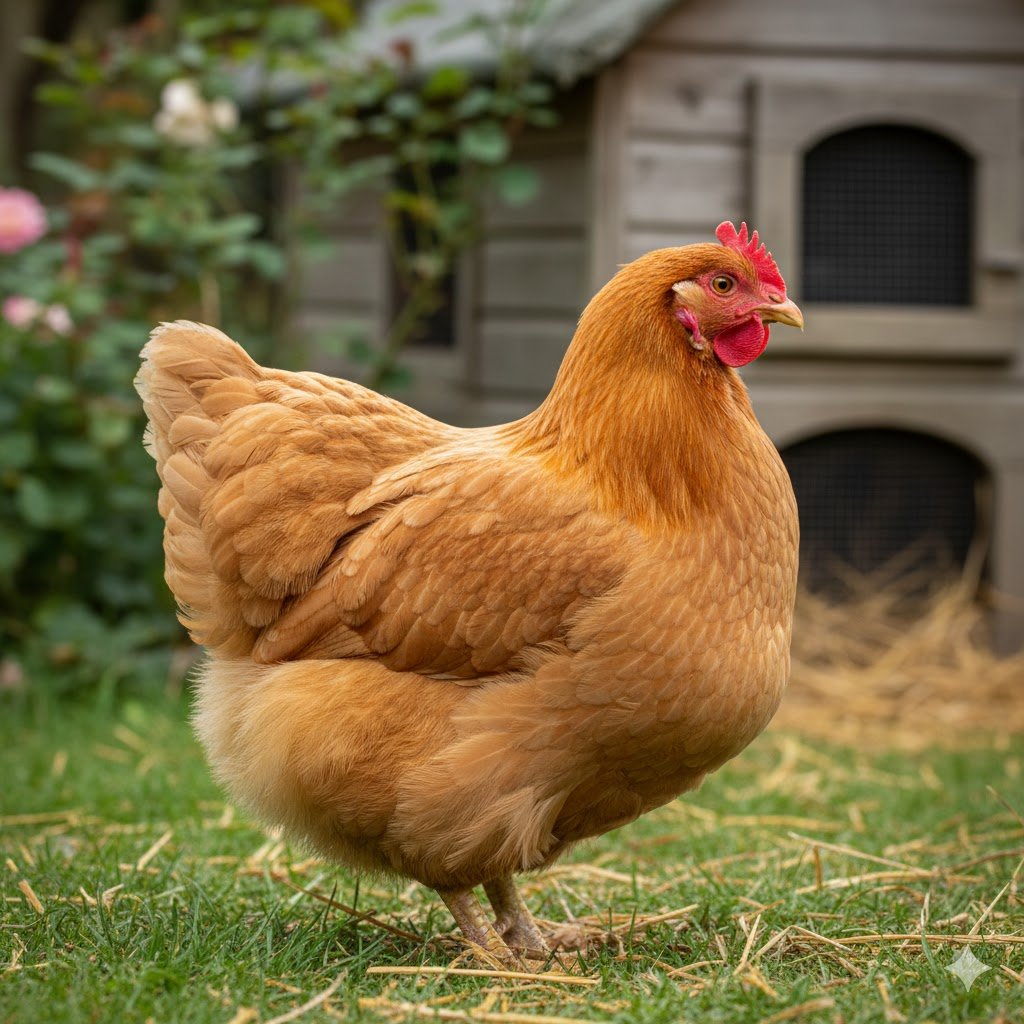
Orpingtons are big, beautiful, fluffy footballs. They are known for their “profuse” soft feathering, which makes them look even larger than they are. They are round, broad, and low to the ground.
The Buff Orpington is the most popular—a lovely, rich golden-buff colour. They are a beautiful sight in any garden. Their fluffy feathers cover their legs and they have a medium-sized single comb.
Orpington Egg Production & Laying Ability
Orpingtons are decent layers, giving you around 160-220 light brown eggs per year. This is a perfectly respectable 3-4 eggs a week. They are not record-breakers like the Sussex, but they are reliable.
Their main “fault” as layers is that they are very prone to going broody.
Are Orpingtons Aggressive?
No. Orpingtons are famous for being the exact opposite of aggressive. They are exceptionally docile, gentle, and calm. They rarely fight, are fantastic with children, and will often happily sit on your lap for a cuddle.
Roosters are also known for being gentle (for a rooster, anyway). Because they are so docile, they, like Dorkings, can be bullied by more assertive breeds.
Orpington Climate Suitability (Heat vs. Cold)
- Cold Weather: They are fantastic in UK winters. Their thick, fluffy down-like feathering acts like a duvet, keeping them perfectly warm.
- Hot Weather: This is their one weakness. They can overheat in a hot summer. It’s essential they have plenty of shade, cool water, and good ventilation in their coop.
How to Manage a Broody Orpington
An Orpington hen will go broody. This means she’ll stop laying, puff herself up, and sit in the nest box 24/7, determined to hatch some eggs (even if there aren’t any).
If you don’t want chicks, you need to “break” her broodiness. This usually involves:
- Removing her from the nest box (repeatedly).
- Placing her in a “broody jail” — a wire-bottomed cage with food and water for a few days. This cools her underside and her hormones.
It feels mean, but it’s necessary for her health. We have a detailed guide to breaking broodiness if you need it.
Orpington Pros and Cons
| Pros | Cons |
|---|---|
| ✅ Incredibly friendly, docile, and cuddly | ❌ Very prone to going broody (stops laying) |
| ✅ Fantastic with children | ❌ Can overheat in hot summers |
| ✅ Excellent in cold UK winters | ❌ Lower egg total (160-220/year) |
| ✅ Wonderful, dedicated mothers | ❌ Fluffy feathers get muddy and waterlogged |
| ✅ Very quiet and calm | ❌ Can be bullied by other breeds |
| ✅ Beautiful, fluffy appearance | ❌ Slower to mature than other breeds |
Care Requirements & Practical Considerations
All three breeds are hardy, but their size and needs differ slightly.
Housing & Space Comparison Chart
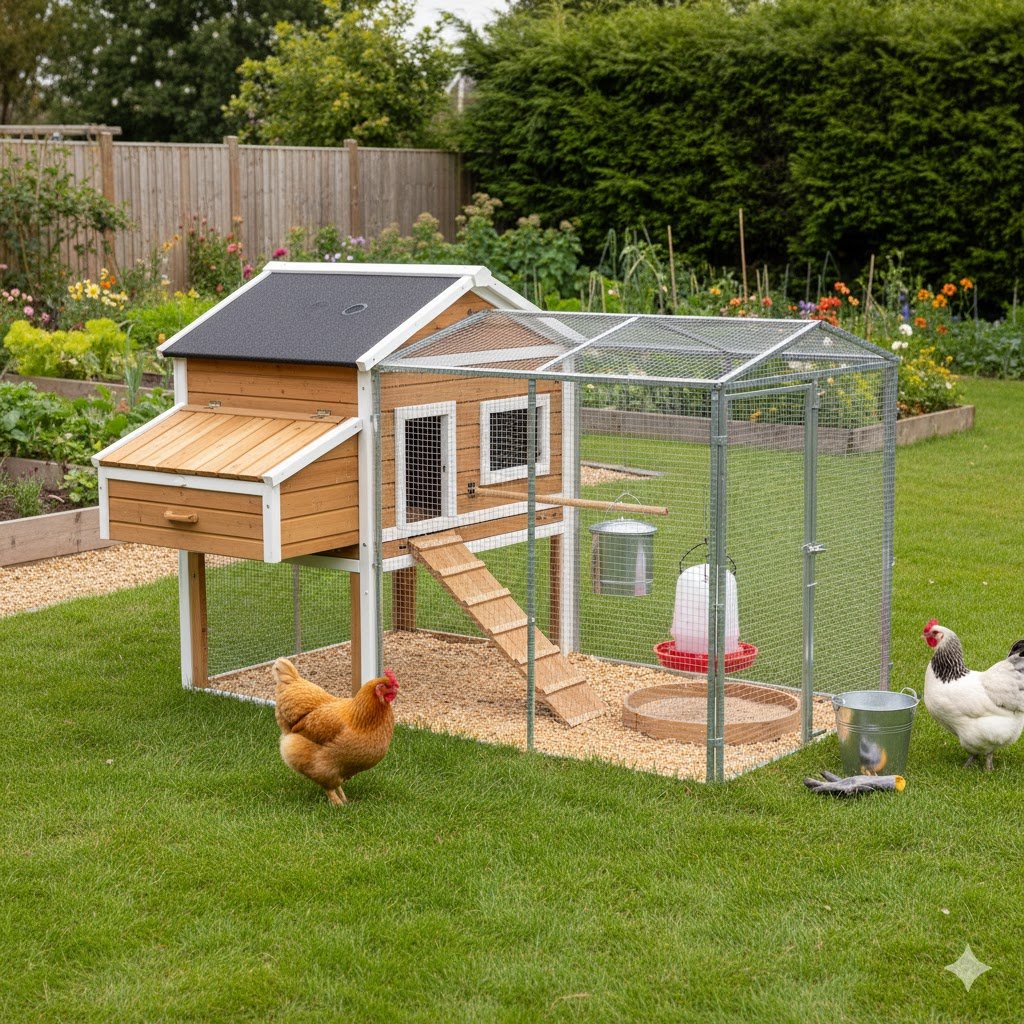
These are all large birds, so they need more space than smaller breeds. Here are the minimums.
| Breed | Min. Coop Space (per bird) | Min. Run Space (per bird) | Roosting Bar Space (per bird) |
|---|---|---|---|
| Sussex | 4 sq ft | 10 sq ft (active foragers) | 10 inches |
| Dorking | 4 sq ft | 8 sq ft (less active) | 10 inches |
| Orpington | 4-5 sq ft (very wide) | 8-10 sq ft | 12 inches |
Don’t buy a tiny, cheap coop from a pet website; they are almost always too small. You can learn more about calculating coop size requirements here. It’s also vital to get one of the best fox-proof chicken coops for UK keepers, as security is essential.
Because these are heavy birds, their roosting perches should be set relatively low, around 12-18 inches (30-45cm) from the floor, to prevent leg injuries when they jump down. And given our climate, check this guide on choosing the right bedding for UK’s damp conditions.
A Basic Feeding Routine
All three breeds are great foragers, which means they will happily spend their day eating bugs, slugs, and plants, cutting down your feed bill!
However, their main diet must be a high-quality “layer pellet” or “layer mash.” This contains the 16-17% protein and all the calcium and vitamins they need to lay eggs and stay healthy.
- Layer Pellets: Provide in a feeder, available all day.
- Fresh Water: This is essential. Clean it daily.
- Treats: A handful of corn in the afternoon (especially in winter) or some greens is fine, but it should only be 10% of their diet.
- Grit: Chickens don’t have teeth; they swallow tiny stones (grit) which go into their “gizzard” to grind up food. You must always have a pot of “chicken grit” available.
- Oyster Shell: Layer pellets have calcium, but laying hens need extra. A separate pot of crushed oyster shell allows them to take what they need to form strong eggs.
For more, see our review of the top UK feed brands.
Important: Under UK law, you cannot feed chickens any kitchen waste that contains or has been in contact with meat or meat products, as this poses disease transmission risks. While feeding vegetable peelings from your own household kitchen to your backyard flock is generally acceptable, it’s best practice to provide commercial feed as the primary diet. For commercial operations, stricter catering waste regulations apply.
Typical Costs for UK Keepers
While keeping chickens is a rewarding hobby, it’s good to be aware of the costs. Prices will vary based on your location and supplier.
- Purchase Price: As a rough guide, expect to pay between £20 – £50 per bird (at point of lay) from a reputable breeder for these traditional breeds. Rare varieties or show-quality birds will cost more.
- Feed Costs: A single large-fowl hen will eat approximately 1.5kg of layer pellets per week. This works out to roughly £30-£45 per bird, per year, depending on your chosen feed brand and supplier.
What Are the Noisiest Chicken Breeds?
A common worry for UK gardens! Luckily, none of these three are considered noisy.
- Quiet: Dorking, Orpington.
- Moderate: Sussex.
The “egg song” (a cackle a hen does after laying) is unavoidable, but it’s brief. Roosters, of course, will crow. But the general, day-to-day clucking of these breeds is quiet and pleasant.
The Importance of the Dust Bath
You don’t bathe your chickens—they do it themselves! A “dust bath” is how they keep their feathers clean and, crucially, how they kill parasites like mites and lice.
They need a patch of dry, loose soil or sand (ideally under cover from the rain) where they can dig a hole and flick dust all over themselves. If your run is all grass, you’ll need to provide one. You can see our complete guide to setting up a dust bath for natural mite prevention.
Flock Health & First-Aid Kit
These breeds are generally very hardy. The main health issues to watch for are:
- Parasites: Red mites (at night in the coop) and lice (on the bird). Check for them regularly.
- Scaly Leg Mite: A parasite that burrows under the leg scales.
- Respiratory Issues: Any sneezing or gurgling, often from a damp or poorly ventilated coop.
It’s wise to have a basic first-aid kit:
- Mite powder/spray (like Diatomaceous Earth).
- Scaly leg treatment.
- Antiseptic spray (for any cuts).
- A “Broody Jail”: A spare dog crate or cage, just in case.
We have a complete red mite prevention and treatment guide which is a must-read for all UK keepers.
This kit is for minor issues. For any serious injuries, sudden illness, or if you’re ever unsure, always contact a qualified vet experienced with poultry.
Legal Welfare Requirements
Beyond specific poultry rules, all keepers in the UK must follow the Animal Welfare Act 2006. This act places a “duty of care” on you to provide for your chickens’ basic needs (often called the Five Freedoms).
For more detailed information, you can read the official welfare guidelines from DEFRA, which provide practical advice on housing, feeding, and care. The RSPCA’s chicken keeping guidelines are also an excellent resource for welfare best practices.
Biosecurity: The GB Poultry Register and Bird Flu
This is a non-negotiable part of modern chicken keeping.
- The Law: Since 1 October 2024, it is a legal requirement for all bird keepers in England and Wales to register with the GB Poultry Register within one month of keeping birds. Registration is free and mandatory even if you only have one bird. (Scotland has separate registration rules).
- Why? It’s to help manage and control outbreaks of Avian Influenza (Bird Flu). If there’s an outbreak in your area, they can text or email you with vital information.
- “Flockdown” / Housing Orders: During high-risk winter periods, DEFRA may issue a “housing order.” This means all birds must be kept indoors or in a fully-netted run to stop them from having contact with wild birds (who carry the disease). You must have a plan for how you will do this if an order is declared. Housing orders vary by region and season based on avian influenza risk. In May 2025, mandatory housing measures were lifted across most areas, but strict biosecurity requirements remain nationwide. Always check the DEFRA website for current restrictions in your area, as regional housing orders can be imposed quickly during outbreaks.
It’s also vital to protect your flock from ground predators. Check our guide on protecting against hawks, buzzards, and other aerial predators.
A Seasonal Calendar: What to Expect Year-Round
- Spring (March-May): Peak egg-laying! As daylight increases, laying resumes in full. Expect 5-6 eggs/week from a good Sussex. This is also the time of peak broodiness, especially for Orpingtons and Dorkings.
- Summer: Watch for overheating in heavy breeds like Orpingtons. Ensure constant shade and fresh, cool water. Red mite populations explode in warm weather, so check the coop weekly.
- Autumn (September-November): The “moult.” Most hens will stop laying and lose their feathers to grow a new set for winter. The annual moult typically lasts 6-8 weeks, during which time egg production will stop.
- Winter: Egg-laying will slow or stop for many… except your hardy Sussex and Dorkings, who will often continue to provide you with eggs.
Where to Find Your Chickens
Reputable Breeders vs. Online Adverts
Where you get your birds from is critical.
- Avoid: Online marketplaces (like Gumtree or Facebook), auctions, and pet shops. You risk getting sick, cross-bred, or old birds.
- Seek Out: Reputable, registered breeders.
How to Find a Good Breeder
We’ve focused on the big three, but if you want a complete list of chicken breeds with pictures, or to find a good breeder, your best bet is to check:
- The Poultry Club of Great Britain: The official body for all breed standards in the UK.
- Specific Breed Clubs: (e.g., The Dorking Club, The Orpington Club). They have member lists and are passionate about preserving the breed.
- The Rare Poultry Society: A fantastic resource for breeds like the Dorking.
I would advise beginners to avoid buying from auction marts, online marketplaces, or “mystery” sellers. You have no guarantee of the bird’s health or breed, and they are often a bad cross.
Frequently Asked Questions (FAQ)
Q: Can I mix Sussex, Dorking, and Orpington chickens in one flock? A: Yes, this is a great “gentle flock” combination. Because all three are docile, you’re unlikely to have major bullying issues. Just be sure to provide plenty of space, and multiple feed/water stations so no one gets pushed out.
Q: Do I need a license to keep chickens in the UK? A: Yes. Since 1 October 2024, it is a legal requirement for all bird keepers in England and Wales to register with the GB Poultry Register, even if you only have one or two birds. This is to help manage and control any outbreaks of bird flu. It’s free and easy to do online via the DEFRA or Animal and Plant Health Agency (APHA) website. (Note: Scotland has separate registration rules).
Q: How long do traditional breeds live? A: Much longer than hybrids. With good care, a heritage hen can live for 5-8 years, sometimes even 10, though her egg-laying will slow down after year 3 or 4.
Q: What is the friendliest chicken breed? A: For a cuddly, lap-chicken, the Orpington wins, hands down. For a bird that’s friendly but more active and independent, the Sussex is a perfect choice.
Q: Which breed is best for meat? A: All three are good dual-purpose breeds. Historically, the Dorking was considered the absolute best-tasting table bird, followed closely by the Sussex.
Conclusion – Which Breed is Right for You?
So, which of our big three is your winner?
- Go for Sussex if: You want the best all-rounder, a reliable egg-layer (especially in winter), and a friendly, active bird for your family.
- Go for Orpington if: Your number one priority is a gentle, cuddly, and calm pet that is fantastic with children (and you don’t mind managing broodiness!).
- Go for Dorking if: You love history, want a super-calm bird, and value delicious winter eggs.
Whichever you choose, you’ll be bringing a wonderful, living piece of British heritage into your garden. For more brilliant reading, check out the British Hen Welfare Trust’s complete guide to keeping chickens as pets. The next step is to find a reputable breeder (check the Poultry Club of Great Britain’s breeder directory), get your coop set up, and get registered with DEFRA. Happy keeping!

Oladepo Babatunde is the founder of ChickenStarter.com. He is a backyard chicken keeper and educator who specializes in helping beginners raise healthy flocks, particularly in warm climates. His expertise comes from years of hands-on experience building coops, treating common chicken ailments, and solving flock management issues. His own happy hens are a testament to his methods, laying 25-30 eggs weekly.
